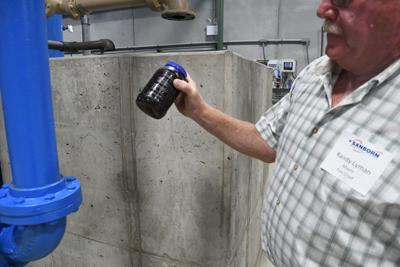SANBORN—The city of Sanborn has a refreshing new addition.
Sanborn Municipal Utilities held an open house for its new water treatment plant on Wednesday. The plant has been operational since April of 2021, but residents were invited to take tours and ask any questions they had this week.
The project was started in March of 2020. Since the plant’s operation, Sanborn’s water quality has greatly improved.
“Our water is 1,000 times better now that we are not drinking deep well water,” said mayor Randy Lyman. “It’s a blessing to the community.”
Before the plant was built, shallow well water was pumped directly into Sanborn’s distribution system. This water was good quality, but the supply was limited. As the town grew residentially and corporately due to the cheese manufacturer Associated Milk Producers Inc., water demand increased. That caused the city to start using deep well water from the Dakota aquifer. The water from the aquifer is high in hardness, sulfates, iron and ammonia which means it is low in quality. That presented a need for a new water treatment system.
“We had a problem keeping up with the water as AMPI grew and in the summertime when the water level is down,” Lyman said. “We started using the deep well water, and that’s when we started getting complaints of dirty water.”
Many residents were unsettled by the water’s yellow appearance, and made it known to the Sanborn City Council.
The Sanborn Water Treatment Plant uses reverse osmosis to remove contaminates from the water. The process filters water through a membrane that allows water molecules to pass through but not the unwanted compounds. The treatment plant uses several of these osmosis filters for the deep well water and three sand filters for the shallow well water. Once the water is filtered, it goes to the two large tanks outside the plant or directly into the city system.
The treated water is 70 percent deep well 30 percent shallow well water. Once the two are treated and combined, the leftover wastewater is sent to the wastewater treatment plant. Some wastewater helps clean and balance the treated water in a reverse osmosis system, like a dishwasher uses water, resulting in less wasted water.
“With reverse osmosis water you have to add some bad water back into it otherwise the alkalinity is too high, and the taste is bad,” Lyman said.
Before the water treatment plant, 350,000 gallons of shallow well water were used a day; now the city uses 70 percent less of that.
The total cost for the project was around $8 million. The cost was shared between residential and industry customers and financed using the Iowa State Revolving Fund, a statewide program jointly administered by the Department of Natural Resources and Iowa Finance Authority for the construction of water and wastewater infrastructure.
Although the project was started at the same time COVID hit, it was finished sooner than most projects of this size. Construction for the facility was done in a year.
“COVID didn’t really affect construction because everything was already ordered,” said Sanborn Public Works superintendent Adam Roelfs.
“Typically, we plan for 18 months to two years for construction” said project engineer Ryan Norman. “This was an accelerated process.”
Norman works for DGR Engineering of Rock Rapids, which designed the plant.
“Surprisingly, everything went pretty smoothly with this project,” Norman said. “Usually when you expedite construction, you expect problems to come up.”
The new plant can treat 900,000 gallons of water per day and can expand to 1.3 million. Day-to-day operations mostly look like running tests on the water and making sure everything is up to code.
“We usually come in here and we check our chlorine and PH levels which gets sent to the DNR” Roelfs said.
Then membranes used in the reverse osmosis filters catch 99 percent of impurities, and last for a decent amount of time.
“There is a cleaning process,” Roelfs said. “We communicate with the manufacturer every month and they have us do some testing but we’re probably looking at a 5-10-year life expectancy out of the membranes.”
